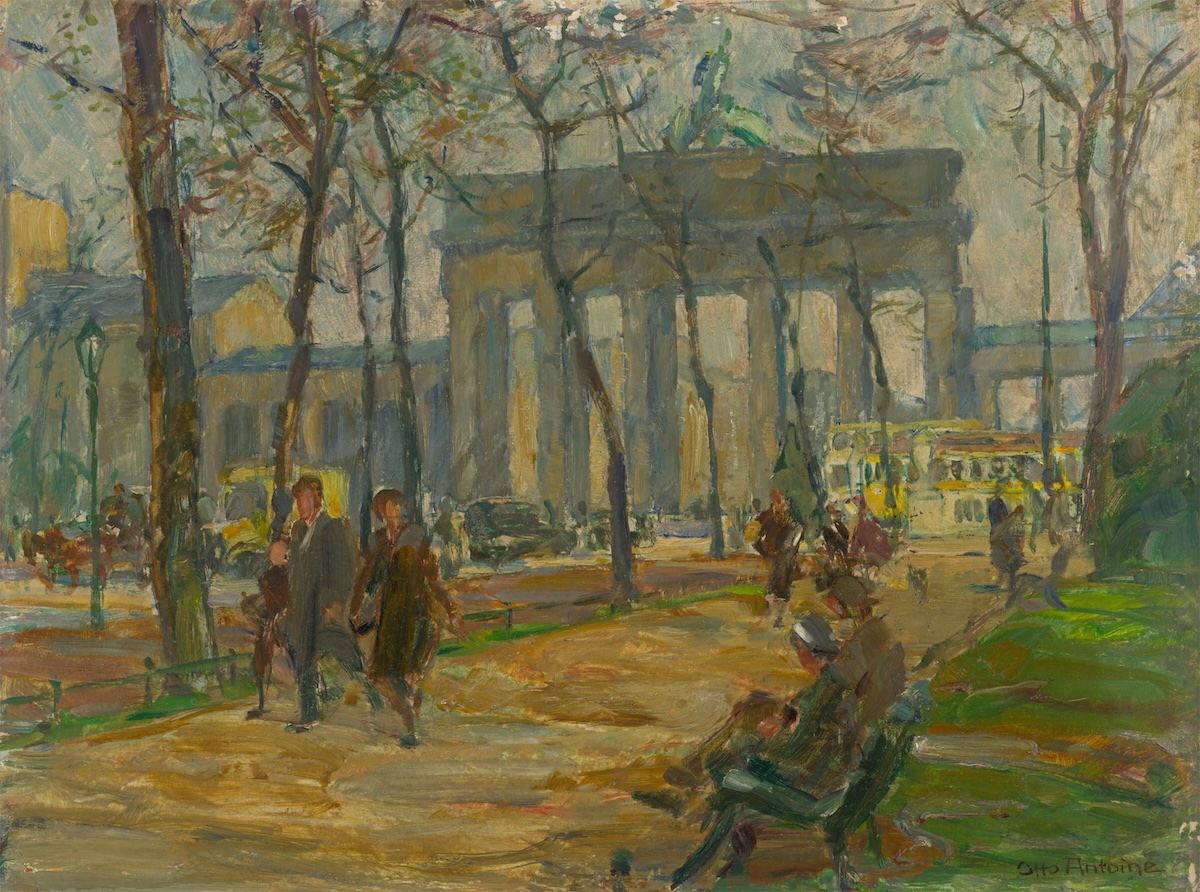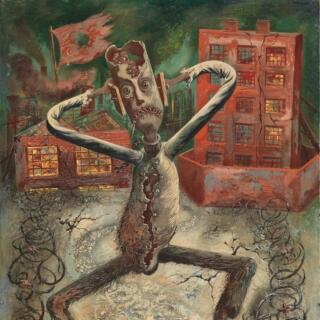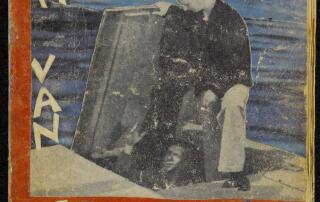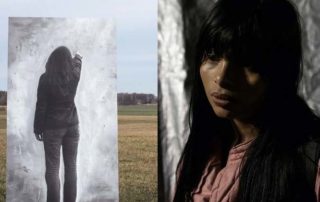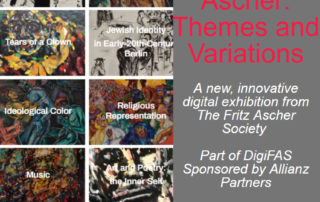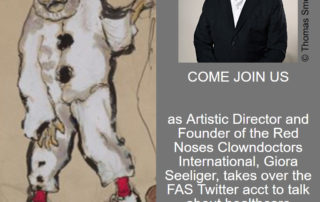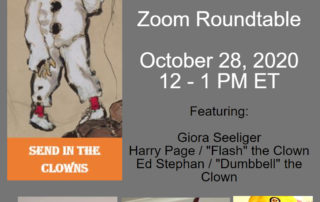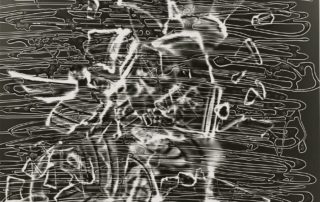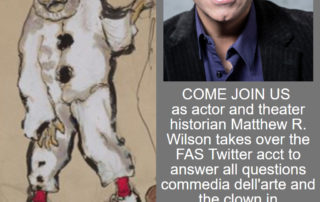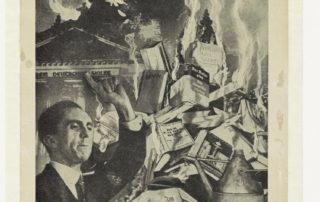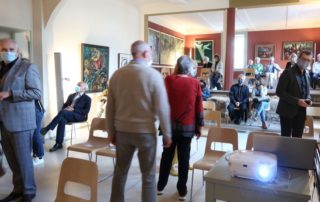Rachel Stern2024-10-09T14:25:07-04:00October 1st, 2024|Events, Lectures, Past Events|
Kathleen Langone speaks about the German born painter Otto Antoine (1865-1951), followed by a conversation with Jacquelyn Delin McDonald from the University of Texas at Dallas. Image above: Otto Antoine, Brandenburg Gate, 1928. Oil on cardboard Antoine displayed an early artistic talent but, due to economic circumstances, started a long-term career as a civil servant, initially as a clerk at a local post office. His drawing abilities were soon recognized, and he increasingly was used as a painter, engraver and designer of stamps for the German postal service. They also sent him to many far-flung places outside of Germany (such as Africa) to paint bucolic landscapes of those countries, which were used to promote their [...]
Rachel Stern2024-07-24T14:45:50-04:00July 2nd, 2024|Events, Lectures, Past Events|
George Grosz (American, b. Germany, 1893–1959) created the “Stick Men” series in Huntington, where he lived from 1947 until shortly before his death. Featuring hollow figures in an apocalyptic landscape, this group of watercolors offers a searing indictment of humanity following World War II, the Holocaust, and the dropping of atomic bombs on Hiroshima and Nagasaki. Grosz was an internationally renowned German-born artist who remained invested in political art following his immigration to the United States in 1933. In the “Stick Men” series, he wrestles with the emergence of Abstract Expressionism and reaffirms the ability of painting to impact society. Image above: Detail of George Grosz (American, b. Germany, 1893–1959), The Grey Man Dances, 1949. Oil on canvas. George [...]
Rachel Stern2024-07-10T16:07:15-04:00June 28th, 2024|Events, Lectures, Past Events|
Under threat from Nazi antisemitism, the young Jewish lawyer Curt Bloch (1908–1975) fled Dortmund for the Netherlands in 1933. He went into hiding there in 1942 and emigrated to the United States after the war. In his hiding place, from August 1943 to April 1945 Bloch produced a magazine with the telling title Het Onderwater Cabaret – “The Underwater Cabaret.” Image above: Curt Bloch, Het Onderwater Cabaret 30 Aug 1943; Jewish Museum Berlin, Convolute/816, Curt Bloch collection, loaned by the Charities Aid Foundation America thanks to the generous support of Curt Blochʼs family Week by week, Curt Bloch created small-format booklets with artfully designed covers, containing a total of 483 handwritten poems in German and [...]
Rachel Stern2022-02-18T05:26:38-05:00July 28th, 2021|Events, Memory, Past Events|
Discussion with artists Luise Schröder (Germany) and Kitra Cahana (Canada) Moderated by Ori Z Soltes, PHD Teaching Professor at Georgetown University in Washington DC Introduced by Rachel Stern Director and CEO of the Fritz Ascher Society in New York NY This program explores the work of two young artists -- Kitra Cahana, from Canada; and Luise Schroeder, from Germany -- whose photography, documentary filmmaking and other work have been informed by an acute awareness of the myriad complications that have beset diverse individuals and groups within the complexities of the twentieth- and twenty-first-century world. Their inspirational sources range from the Holocaust to the Black Lives Matter movement as, in similar and yet very different ways, they [...]
Rachel Stern2020-11-24T20:14:35-05:00October 14th, 2020|Newsletter|
Dear Friends, On October 17 we celebrate Fritz Ascher’s birthday - this year with the launch of DigiFAS - diverse, innovative digital initiatives that provide new ways of engagement with the art and life of artists persecuted by an authoritarian regime. DigiFAS is generously sponsored by Allianz Partners. This launch includes the Society’s first-ever fully digital exhibition “Fritz Ascher: Themes and Variations.” You can explore the exhibition HERE. We have worked on this for months and can’t wait for your reactions! We also invite you to participate in the 2- week digital engagement project “Send in the Clowns,” which explores the clown as a figure between tragedy and comedy, between self- identification [...]
Rachel Stern2020-11-02T20:09:58-05:00September 30th, 2020|Events, Past Events, Send in the Clowns|
Twitter @Ascher_Society Giora Seeliger, Artistic Director and Founder of Red Noses Clowndoctors International, takes over the FAS Twitter account to answer your burning questions about clowning, the role of a healthcare clown, and anything else that comes to mind! Submit your questions in advance by writing to info@fritzaschersociety.org Part of "Send in the Clowns," an interactive two-week digital initiative, which explores the clown as a figure between tragedy and comedy, between self- identification and stage--a character designed to (literally) mask the performer’s true feelings behind a facade of happiness. “Send in the Clowns” uses the prominence of the “clown” figure in Fritz Ascher’s work as a lens through which to explore the duality of the clown both historically and today. [...]
Rachel Stern2020-10-28T14:24:47-04:00September 30th, 2020|Events, Past Events, Send in the Clowns|
Watch the recording of this event HERE. Roundtable featuring Giora Seeliger Artistic Director and Founder of the Red Noses Clowndoctors International Harry Page “Flash” the Clown Ed Stephan “Dumbbell” the Clown Moderated by Elizabeth Berkowitz Art Historian and Digital Interpretation Manager, The Fritz Ascher Society in New York One of the more appealing aspects of the clown subject to artists like Fritz Ascher was the divide between a public persona committed to joy and happiness, and the pain or sadness that might lurk beneath the real, human surface. Hospital or healthcare clowns straddle this divide every day of their professional lives—working to bring happiness to child patients who are often in circumstances that might otherwise inspire grief or pain. This [...]
Rachel Stern2022-03-06T11:39:32-05:00September 30th, 2020|Events, Lectures, Past Events|
Lecture by Lynette Roth Daimler Curator of the Busch-Reisinger Museum and Head of the Division of Modern and Contemporary Art at the Harvard Art Museums Moderated by Rachel Stern Executive Director of the Fritz Ascher Society in New York Anneliese Hager (1904-1997) is one of a number of modern artists who began their artistic experimentation in Germany after National Socialist cultural policy began to harden against all forms of modern art. Her preferred medium was the photogram, a photographic image made by placing an object directly on (or in close proximity to) a light-sensitive surface and exposing it to light. Hager called the reversal of light and dark in the resulting contact print “white shadows.” [...]
Rachel Stern2020-09-29T20:08:44-04:00September 29th, 2020|Events, Send in the Clowns|
Twitter @Ascher_Society Actor and theater historian Matthew R. Wilson takes over the FAS Twitter account to discuss the history of the Commedia dell’Arte, key themes in the genre, and how the Commedia dell’Arte has impacted popular culture. Submit your questions in advance by writing to info@fritzaschersociety.org Part of "Send in the Clowns," an interactive two-week digital initiative, which explores the clown as a figure between tragedy and comedy, between self- identification and stage--a character designed to (literally) mask the performer’s true feelings behind a facade of happiness. “Send in the Clowns” uses the prominence of the “clown” figure in Fritz Ascher’s work as a lens through which to explore the duality of the clown both historically and today. Generously sponsored [...]
Rachel Stern2020-10-22T00:35:30-04:00September 29th, 2020|Events, Past Events, Send in the Clowns|
Watch the recording of this event HERE. Roundtable featuring Matthew R. Wilson Director (SDC), Actor (AEA, SAG-AFTRA), and Fight Director (SAFD, SDC), as well as a scholar and playwright Ori Z. Soltes Teaching Professor at Center for Jewish Civilization, Georgetown University, Washington D.C. Tricia Manuel / "Pricilla Mooseburger" the Clown Tricia Manuel is the unmistakable Pricilla Mooseburger! Moderated by Elizabeth Berkowitz Art Historian and Digital Interpretation Manager, The Fritz Ascher Society in New York How do we define “the clown,” historically, in art, and today, in practice? What is the appeal of the clown in performance, and how has the clown subject impacted popular culture? This roundtable pools the expertise from a diversity of fields to place Fritz Ascher’s interest in “the [...]
Rachel Stern2020-11-04T15:01:37-05:00September 17th, 2020|Events, Lectures, Past Events|
WATCH THE RECORDING OF THIS EVENT HERE. Lecture featuring Rosa von der Schulenburg, Head of the Art Collection of the Academy of Arts in Berlin Moderated by Rachel Stern, Executive Director of the Fritz Ascher Society in New York John Heartfield (1891-1968) was a German visual artist who pioneered the use of art as a political weapon. This presentation starts with preliminary remarks about John Heartfield’s bequest in the Akademie der Künste in Berlin and shows how it is accessible nowadays. A short introduction of how all began follows, showing the background of the birth of Heartfield’s political photo-montages (World War I, Dada, Communist Party, Willi Münzenberg’s Die Arbeiter-Illustrierte-Zeitung in short AIZ), glances at Heartfield’s first exile stage in Prague and then focuses on [...]
Rachel Stern2020-09-17T22:58:37-04:00September 17th, 2020|Newsletter|
Forum Jacob Pins in Höxter, Germany Dear Friends, The Jewish New Year is upon us, and it feels as if the New keeps coming. The exhibition “The Loner. Clowns in Fritz Ascher's Art (1893-1970)” at Forum Jacob Pins in Höxter, Germany was opened with an event following social distancing rules, my video greeting and a concert in the courtyard. The exhibition is on view until November 29, and I very much encourage you to see it (more information HERE). In the exhibition, Ascher’s depictions of clowns are contrasted with depictions of nature, which dominated his post-Holocaust work. Inspired by the nearby Grunewald, the artist created vivid landscapes and powerful close-ups of the sun, trees and flowers, which [...]


